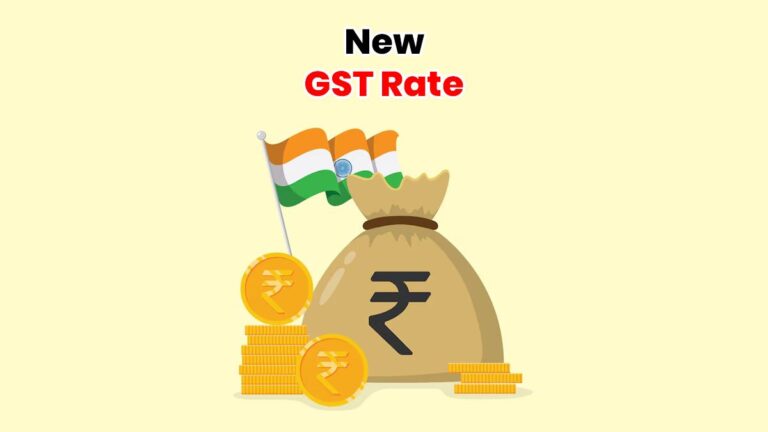Get the latest updates on new GST rates, reforms, slabs, and GST changes. See what’s cheaper, costlier, and how the new GST rate list impacts you.
Table of Contents
Why the New GST Rates Matter
The Goods and Services Tax (GST) has been India’s biggest tax reform, replacing multiple indirect taxes with a unified structure. Recently, the government announced major GST reforms—introducing new GST rates, updating GST slabs, and publishing a fresh GST rate list. These GST changes aim to make the system simpler, reduce inflation, and provide relief to consumers and businesses alike.
Let’s break down the key updates in 5–6 easy sections.
1. Simplified GST Slabs
Earlier, GST was divided into four main slabs—5%, 12%, 18%, and 28%. Now, the structure has been streamlined into:
- 0% (Nil GST) – For essential items like milk, paneer, roti, erasers, and certain medicines.
- 5% slab – For household goods like soap, shampoo, toothpaste, snacks, chocolates, kitchen items, and packaged food.
- 18% slab – For appliances (TVs, ACs, washing machines), cement, small vehicles, motorcycles, and auto parts.
- 40% slab – For luxury and sin goods like tobacco, aerated drinks, pan masala, premium vehicles, and cigarettes{1}.
This new slab system makes it easier to classify goods and services under the new GST rate list.
2. Key GST Changes
Some of the most notable GST changes include:
- Reduction of rates on everyday essentials to 5% or 0%.
- Removal of the 12% and 28% slabs for most common goods.
- Introduction of a 40% slab for sin and luxury items.
- GST exemption on health insurance, life insurance, and select medicines.
- A simpler compliance process for businesses with fewer tax categories.
3. Impact on Consumers
Consumers will benefit directly from the new GST rates:
- Cheaper essentials – Food, toiletries, dairy, and snacks are now either 0% or 5%.
- Lower appliance costs – Many household items that were at 28% are now down to 18%.
- Relief on services – Insurance and healthcare services have become GST-free, making them more affordable.
- Higher luxury costs – Cigarettes, aerated drinks, and luxury cars will be pricier due to the 40% slab.
These reforms are designed to put more money in consumers’ pockets and reduce inflation pressure{2}.
4. Impact on Businesses
The new GST slabs also reshape the business landscape:
- FMCG companies will see higher demand as essentials become cheaper.
- Electronics and auto sectors are likely to gain from reduced tax rates, encouraging more sales.
- Insurance providers benefit as GST-free health and life insurance could attract more customers.
- Luxury brands may face slower demand due to the steep 40% GST slab.
Overall, the GST reforms are expected to boost consumption and support small businesses.
5. Benefits for the Economy
The GST changes aren’t just about cheaper products—they’re also about long-term growth. Key benefits include:
- Simplified compliance with fewer tax slabs.
- Greater transparency in billing and pricing.
- Increased consumer spending, which can drive GDP growth.
- A fairer system where essentials are affordable, and luxury items bear higher taxes.
- Potential inflation reduction by easing prices of everyday goods{3}.
6. Updated GST Rate List at a Glance
| GST Slab | Examples of Items |
|---|---|
| 0% | Milk, paneer, roti, erasers, medicines |
| 5% | Soap, shampoo, toothpaste, snacks, cereals |
| 18% | TVs, ACs, washing machines, small cars, cement |
| 40% | Cigarettes, tobacco, aerated drinks, luxury cars |
Conclusion
The new GST reforms have reshaped India’s taxation by introducing simplified new GST slabs, updated GST rates, and a consumer-friendly GST rate list. These GST changes bring relief to households, support business growth, and strengthen the economy while ensuring luxury and sin goods bear higher taxes.
FAQs on New GST Rates and GST Changes
What are the new GST rates?
What are the new GST rates?
What are GST reforms?
GST reforms are changes made to simplify tax slabs, reduce rates, and improve compliance.
What items are now tax-free?
Milk, paneer, roti, erasers, and some medicines are GST-free.
Which products are under the 5% GST slab?
Soap, shampoo, toothpaste, cereals, snacks, chocolates, and packaged food.
What falls under the 18% GST slab?
Electronics, appliances, cement, small cars, motorcycles, and auto parts.
What goods are taxed at 40%?
Tobacco, aerated drinks, pan masala, luxury cars, and premium indulgences.
How do GST changes affect consumers?
Everyday essentials are cheaper, while luxury and sin goods cost more.
How do GST reforms benefit businesses?
Simpler slabs, reduced compliance, and higher demand in FMCG and auto sectors.
Will the new GST rates reduce inflation?
Yes, prices of essential goods and appliances are expected to fall, lowering inflation.
From when are the new GST slabs effective?
The new GST slabs are effective from September 22, 2025.
By PaisaInvests



